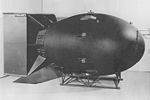- Effects of nuclear explosions on human health
-
- See also Effects of Nuclear Explosions
Nuclear weapons 
History
Warfare
Arms race
Design
Testing
Effects
Delivery
Espionage
Proliferation
Arsenals
Terrorism
Anti-nuclear oppositionNuclear-armed states United States · Russia
United Kingdom · France
China · India · Israel
Pakistan · North Korea
South Africa (former)The medical effects of a nuclear blast upon humans can be put into four categories:
- Initial stage -- the first 1–9 weeks, in which are the greatest number of deaths, with 90% due to thermal injury and/or blast effects and 10% due to super-lethal radiation exposure
- Intermediate stage -- from 10–12 weeks. The deaths in this period are from ionization radiation in the median lethal range
- Late period -- lasting from 13–20 weeks. This period has some improvement in survivors' condition.
- Delayed period -- from 20+ weeks. Characterized by “numerous complications, mostly related to healing of thermal and mechanical injuries coupled with infertility, sub-fertility and blood disorders caused by radiation.” Also, ionizing radiation from fallout can cause genetic effects, birth defects, cancer, cataracts and other effects in organs and tissue.
Some scientists estimate that a nuclear war that resulted in 110 Hiroshima-size atomic explosions would cause significant loss of life, in the tens of millions. There would also be much soot thrown up into the atmosphere which would blanket the earth, causing the disruption of food chains.[1][2]
Contents
Blast effects - the initial stage
Immediate post-attack period
The main causes of death and disablement in this state are thermal burns and the failure of structures resulting from the blast effect. Injury from the pressure wave is minimal in contrast because the human body can survive up to 2 bar (30 psi) while most buildings can only withstand a 0.8 bar (12 psi) blast. Therefore, the fate of humans is closely related to the survival of the buildings around them.[3]
Fate within certain peak overpressure
- over 0.8 bar (12 psi) - 98% dead 2% injured
- 0.3-0.8 bar (5-12 psi) - 50% dead 40% injured 10% safe
- 0.14-0.3 bar (2-5 psi) - 5% dead 45% injured 50% safe[3]
Types of radioactive exposure after a nuclear attack
In a nuclear explosion the human body can be irradiated by at least three processes. The first (the major cause of burns) is not caused by ionizing radiation.
- Thermal burns from infrared heat radiation.
- Beta burns from shallow ionizing beta radiation (this would be from fallout particles; the largest particles in local fallout would be likely to have very high radioactivity because they would be deposited so soon after detonation; it is likely that one such particle upon the skin would be able to cause a localized burn). However, these decay particles are very weakly penetrating and have a short range.
- Gamma burns from highly penetrating gamma radiation. This would likely cause deep gamma penetration within the body, which would result in uniform whole body irradiation rather than only a surface burn. In cases of whole body gamma irradiation (circa 10 Gy) due to accidents involving medical product irradiators, some of the human subjects have developed injuries to their skin between the time of irradiation and death.
- See also Nuclear Fallout
In the picture on the right, the normal clothing that the woman was wearing would have been unable to attenuate the gamma radiation and it is likely that any such effect was evenly applied to her entire body. Beta burns would be likely all over the body due to contact with fallout, but thermal burns are often on one side of the body as heat radiation does not penetrate the human body. In addition, the pattern on her clothing has been burnt into the skin. This is because white fabric reflects more infra-red light than dark fabric. As a result, the skin underneath dark fabric is burned more than the skin covered by white clothing.
There is also the risk of internal radiation poisoning by ingestion of fallout particles.
Radiation poisoning
Main article: Radiation poisoningRadiation poisoning, also called "radiation sickness" or a "creeping dose", is a form of damage to organ tissue due to excessive exposure to ionizing radiation. The term is generally used to refer to acute problems caused by a large dosage of radiation in a short period, though this also has occurred with long term exposure to low level radiation. Many of the symptoms of radiation poisoning occur as ionizing radiation interferes with cell division. There are numerous lethal radiation syndromes including prodromal syndrome, bone marrow death, central nervous system death and gastrointestinal death.[4]
Prodromal syndrome
In prodromal (initial) syndrome, a dose of 1.5 gray or less is not lethal, but causes gastrointestinal distress such as anorexia, nausea, fatigue and possibly diarrhea.[4]
Bone marrow death
Bone marrow death is caused by a dose of radiation between 2 and 10 gray and is characterized by the part of the bone marrow that makes the blood being broken down. Therefore production of red and white blood cells and platelets is stopped by division of precursor stem cells ceasing (4.5 gray kills 95% of stem cells). The loss of platelets greatly increases the chance of fatal hemorrhage. While the lack of white blood cells causes septicemia infections, the fall in red blood cells is minimal and only causes mild anemia.[4]
The exposure to 4.5 gray of penetrating gamma rays has many effects that occur at different times:
In 24 hours:[4]
These will usually abate after 6–7 days.
Within 3–4 weeks there is a period of extreme illness.[4]
- severe bloody diarrhea, indicating intestinal disorders causing fluid imbalance
- extensive internal bleeding
- septicemia infections
The peak incidence of acute BM death corresponds to the 30 day nadir in blood cell numbers. The number of deaths then falls progressively until it reaches 0 at 60 days after irradiation. The amount of radiation greatly affects the probability of death. For example over the range of 2 to 6 gray the probability of death in untreated adults goes from about 1% to 99%, but these figures are for healthy adults. Therefore results may differ because of the thermal and mechanical injuries and infectious conditions.[4]
Gastrointestinal death
Gastrointestinal death is caused by a dose of radiation between 10 and 50 gray. Whole body doses cause damage to epithelial cells lining the gastrointestinal tract and this combined with the bone marrow damage is fatal. All symptoms become increasingly severe causing exhaustion and emaciation in a few days and death within 7–14 days from loss of water and electrolytes.[4]
The symptoms of gastrointestinal death are:[4]
- gastrointestinal pain
- anorexia
- nausea
- vomiting
- diarrhea
Central nervous system death
Central nervous system death is the main cause of death in 24–48 hours among those exposed to 50 gray.[4]
The symptoms are:[4]
- vomiting
- nausea
- diarrhea
- drowsiness
- lethargy
- tremors
- delirium
- frequent seizures
- convulsions
- prostration
- coma
- respiratory failure
- death
Short term effects (6-8 weeks)
Skin
The skin is susceptible to beta-emitting radioactive fallout. The principal site of damage is the germinal layer, and often the initial response is erythema (reddening) due to blood vessels congestion and edema. Erythema lasting more than 10 days occurs in 50% of people exposed to 5-6 gray.[4]
Other effects with exposure include:[4]
- 2-3 gray--temporary hair loss
- 7 gray--permanent epilation occurs
- 10 gray--itching and flaking occurs
- 10-20 gray--weeping blistering and ulceration will occur
Lungs
The lungs are the most radiosensitive organ, and radiation pneumonitis can occur leading to pulmonary insufficiency and death (100% after exposure to 50 gray of radiation), in a few months.
Radiation pneumonitis is characterized by:[4]
- Loss of epithelial cells
- Edema
- Inflammation
- Occlusions of airways, air sacs and blood vessels
- Fibrosis
Ovaries
A single dose of 1-2 gray will cause temporary damage and suppress menstruation for periods up to 3 years; a dose of 4 gray will cause permanent sterility.[4]
Testicles
A dose of 0.1 gray will cause low sperm count for up to a year; 2.5 gray will cause sterility for 2 to 3 years or more. 4 gray will cause permanent sterility.[4]
Long term effects
Cataract induction
The timespan for developing this symptom ranges from 6 months to 30 years to develop but the median time for developing them is 2–3 years.[4]
- 2 gray of gamma rays cause opacities in a few percent
- 6-7 gray can seriously impair vision and cause cataracts
Cancer induction
Cancer induction is the most significant long term risk of exposure to a nuclear bomb. Approximately 1 out of every 80 people exposed to 1 gray will die from cancer and 1 in 40 people will get cancer. Different types of cancer take different times for them to appear:[4]
- 2 years for leukemia to appear
- 20 or more years for skin cancer or lung cancer
In utero effects
1 gray dose of radiation will cause between 0 and 20 extra cases of perinatal mortality, per 1,000 births and 0-20 cases of severe mental sub normality. 0.05 gray will increase death due to cancer 10 times, to 5 per 1,000. An antenatal dose of 1 gray in the first trimester causes the risk of fatal cancer to increase to 100%.[4]
Transgenerational genetic damage
Exposure to even relatively low doses of radiation generates genetic damage in the progeny of the irradiated organisms. This damage can accumulate over several generations. [1]
Infectious diseases resulting from nuclear attack
The main long term effects of a nuclear blast are infectious diseases caused by contaminated water, untreated sewage, crowded living conditions, poor standard of living, and lack of vaccines in the aftermath. These diseases include:[3]
- Dysentery
- Infectious hepatitis
- Salmonellosis
- Cholera
- Meningococcal meningitis
- Tuberculosis
- Diphtheria
- Whooping cough
- Polio
- Pneumonia
See also
Notes
- ^ Philip Yam. Nuclear Exchange, Scientific American, June 2010, p. 24.
- ^ Alan Robock and Owen Brian Toon. Local Nuclear War, Global Suffering, Scientific American, January 2010, p. 74-81.
- ^ a b c Middleton, Hugh. "Medical Consequences of Radiation Following a Global Nuclear War." The Aftermath (1983): 50-56.
- ^ a b c d e f g h i j k l m n o p q r Coggle, J.E., Lindop, Patricia J. "Medical Consequences of Radiation Following a Global Nuclear War." The Aftermath (1983): 60-71.
Categories:- Nuclear weapons
- Public health
- Radiobiology
- Radiation health effects
Wikimedia Foundation. 2010.


